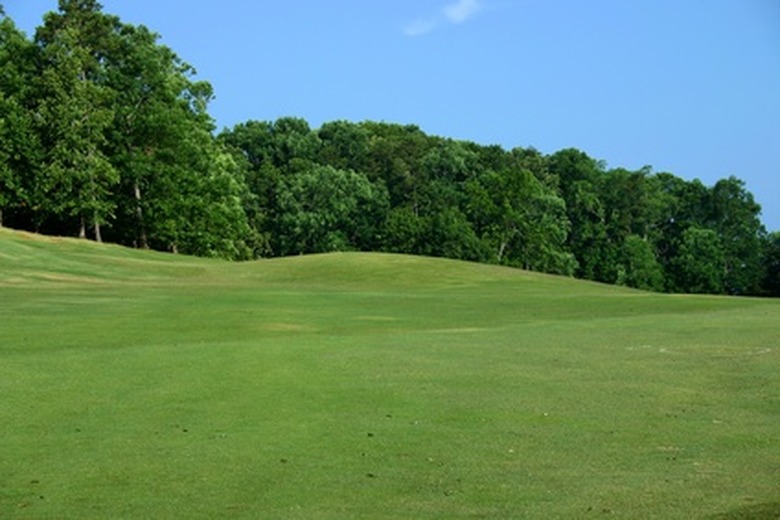Fairway Grass Types
Golfers ask a lot of their fairway grasses. They must endure heavy foot traffic in any kind of weather yet maintain an even, springy, smooth-textured surface atop grass blades mowed no longer than 1 inch high. They must spread quickly to fill in divots and resist invasion by weed species. The best choice of fairway grass depends on the climate and soil type at any particular golf course.
Bermuda Grass
The Texas Cooperative Extension calls the nine species of Bermuda grass (Cynodon spp.) the "sports turf of the South" for its multiple turf-grass uses in warm regions, including ball fields, parks, and both the rough and fairways of golf courses. The most common fairway species of Bermuda grass is Cynodon dactylon, which is abundantly fertile and includes enough intraspecies variation to grow under a broad variety of moisture conditions. But Bermuda grass is not shade or cold tolerant, and will not grow in less than full light or in regions where daytime temperatures are consistently below 75 degrees.
- Golfers ask a lot of their fairway grasses.
- the "sports turf of the South" for its multiple turf-grass uses in warm regions, including ball fields, parks, and both the rough and fairways of golf courses.
Fescue and Bentgrass
The legendary golf courses of England and Scotland sport fairways of fine fescue (Festuca spp.), usually blended with browntop bentgrass (Agrostis capilleris). According to Bob Vavrak, a turf adviser writing for the United State Golf Association, this beautiful fairway grass combination may not be the most appropriate choice for many American fairways. The coastal climates of St. Andrews and other premier European courses are mild and moist, but not oversaturated, all the year-round, providing an ideal environment for fine fescues. Fescue also does not tolerate heavy traffic well and cannot stand up to American motorized golf cart use. But the many varieties of fine fescue available, and its ability to be used in blends with bentgrass or ryegrass, mean it is worth considering on fairways with well-drained, fertile soil and moderate annual temperature variations.
Bluegrass and Ryegrass
The University of Kentucky Extension suggests consideration of Kentucky bluegrass and ryegrass for fairways in America's mid-latitude transition zones. Kentucky bluegrass (Poa pratensis) is one of the most common lawn grasses in the United States. It spreads sideways through rhizomes, making it ideal for filling in fairway divots, and it has some shade tolerance. Unfortunately Kentucky bluegrass does not thrive cut to heights less than 1 inch, leaving little margin for error in golf course turf mowing. The Kentucky Extension recommends using one of the newer, improved varieties of Kentucky bluegrass for fairways, and selecting a blend of two or more varieties for increased resiliency. Perennial ryegrass can be blended with bluegrass, is similarly shade tolerant and has a greater capacity to withstand traffic. A blend of bluegrass and ryegrass may provide the ideal combination for mid-American fairways.
- The legendary golf courses of England and Scotland sport fairways of fine fescue (Festuca spp.
- ), But the many varieties of fine fescue available, and its ability to be used in blends with bentgrass or ryegrass, mean it is worth considering on fairways with well-drained, fertile soil and moderate annual temperature variations.
